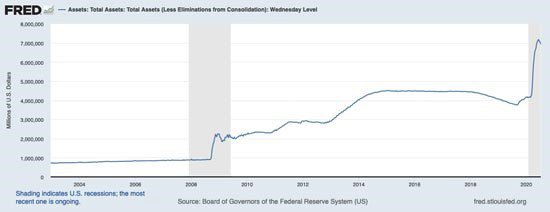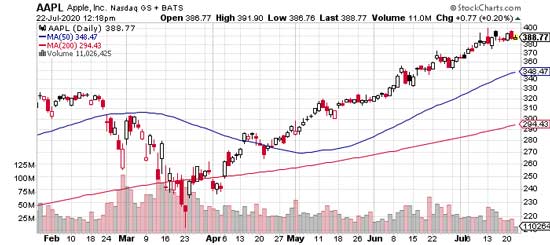Like it has been since March, truly good news is kind of thin on the ground.
The economic recovery is slowing as cases of coronavirus skyrocket in regions that were spared the worst of the initial winter and spring 2020 outbreaks.
And yet stocks have largely made up their March losses, with the NASDAQ Composite in particular blowing right past its early 2020 highs to all-new territory.
In fact, we've seen the fastest and perhaps unlikeliest stock market rally in American history all while getting bad news this year...
Frankly, this performance is because of, not despite, bad news - or, more to the point, unprecedented measures the Fed has taken in an unprecedented crisis.
When we look closer, it's actually a pretty amazing feat of "financial alchemy" that U.S. Federal Reserve Chair Jerome Powell has pulled off - and understanding it is the key to picking the right shares to buy now, like these two "bad news is good news" stocks to pick up today...
It's All About Stimulus, Stimulus, Stimulus... Again
In a bid to prop up the U.S. economy and the global financial system amid the COVID-19 pandemic, the Fed has grown its balance sheet at record speeds, from an already enormous $4.2 trillion to more than $7 trillion:

Much of this stimulus money has been spent on the same sort of quantitative easing (QE) we saw after the 2008 financial crisis. QE is accomplished mostly through buying U.S. Treasury bonds and mortgage-backed securities, with the effect of pushing down bond yields, interest rates, and mortgage rates.
There's much more - this is where the "unprecedented" part comes into play: Unlike in 2008, this time around, the Fed has also said it will buy corporate bonds and even bond exchange-traded funds (ETFs). It has already been doing both.
My Dark Edge dashboard makes these moves even more starkly apparent. It tracks the constant flow of money into cash, bonds, stocks, commodities, metals - and more. Right now, it's lit up like the Fourth of July. This information helps me make trading research recommendations - like the 101% winning move on ATVI - for my Dark Edge Project Members (you can go here to learn how to subscribe).
The theory behind these moves is simple:
- Lower bond yields make it easier for companies to issue more debt, which will help keep them afloat.
- Lower interest rates make it more rational for people to spend their money than to save it, which gets the economy going.
- Lower mortgage rates make more people buy houses, which gets the important construction and housing industries moving.
In practice, there are plenty of secondary consequences. One of the biggest is the stock market rally.
It's not rational for people who still have money to put it in their bank account, because interest rates are too low. Many types of real estate investment trusts (REITs) and other housing investments seem unattractive or impractical now, with mortgage rates this low.
And don't even think about putting that money in bonds hoping for income, as the trifling yields there won't even cover inflation.
And with travel restricted, museums closed, restaurants and bars shuttered or at low capacity, and in general not much to do, there are few "luxuries" available to spend money on.
So, like water running downhill, the excess, "unused" money all ends up finding its way to the stock market.
The result? The four-month gains of 52% in the Nasdaq, 44% in the S&P 500, and 43% in the Dow.
The only thing that seems to slow it down is - surprisingly - seemingly good news from the Fed...
The Only Thing That Could Halt the Rally
At this point, the rally has gone on long enough that making sense of these stock prices without Fed stimulus would be a difficult task.
That's perfectly fine. Realistically, the Fed will not be raising interest rates or ending its QE any time this year, and probably not next year, either.
But with so many fingers in so many pies, there are many small adjustments the Fed can make to its stimulus program. Each change can affect some small part of the market in very significant ways, without ending the stimulus program as a whole.
That possibility is making investors and traders even more sensitive to what Fed Chair Powell and other Fed officials say or do than usual.
For example, earlier this month, Daleep Singh, the executive vice president of the New York Fed and head of the New York Fed's Markets Groups, said that the bank was slowing down its purchases of corporate bonds because that market had recovered after $8 billion worth of Fed purchases.
Potentially, Singh said, these purchases could stop completely, provided the corporate bond market continues to improve.
That sounds like a good sign on the surface - corporate bonds could seem to be regaining strength. But markets took an immediate, sharp nose dive... before recovering, of course.
Last week, Dallas Fed President Robert Kaplan said emergency lending facilities launched by the central bank were necessary to support market function, "but they won't be left in place indefinitely."
Again, broadly optimistic: Market functions will recover and regain their vigor at some point.
And the market did a 600-point reversal.
As you can see, traders are jittery about the Fed. They overreact negatively to any notion that Fed stimulus might end, even though the Fed says it would restart its programs quickly if they became necessary again.
On the other hand, record-high COVID-19 cases in Florida would seem to be bad news. As would July's news that the service sector is recovering slightly slower than expected. We would think these news items would trigger similar market dives.
These developments sent markets higher. Just like with the inverted response to the New York Fed's announcement, this apparent paradox comes down to the Fed's stimulus.
The Fed stimulus is meant to support the economy from the ravages of COVID-19. So if COVID-19 gets worse or the recovery is slow, that means the Fed will continue its stimulus programs.
In other words, bad news is good news...
It may even extend or enlarge them. In a largely Fed-driven market, that's bullish.
More "financial alchemy"...
There is one catch...
Dire, unexpectedly bad COVID-19 news would still send markets down. They keep going up only as long as the bad news is just bad enough to keep the Fed stimulating the economy, but not bad enough to scare away investors.
As long as the bad news stays in this bizarre "Goldilocks Zone" of bad-but-not-bad-enough - bad enough for Big Media to hype it and for the Fed to stimulate the economy because of it, but not bad enough to spook investors - markets will keep rallying.
And with better treatments for COVID-19 than before and a slightly younger population being infected, things are not yet as bad as Big Media is saying they'll get. We can still avoid the worst outcomes if we act now.
There's also hope that U.S. exports may start recovering soon, now that East Asia and Europe are opening back up and recovering. That would be a good sign for U.S. export stocks that don't depend solely on what's happening here.
The profit opportunities in this reality are found in two export-heavy stocks.
Companies with Foreign Exposure are "Just Right" for Profits
First up, we have Nike Inc. (NYSE: NKE), which gets 41% of its revenue internationally and is very China-heavy in that percentage.
Nike has been holding firm above the 50- and 200-day moving averages and is due for a new breakout from its current volatility squeeze:

Apple Inc. (NYSE: AAPL) made a whopping 60% of its 2019 Q4 revenue outside the United States. The stock has been on a tear, and as Asian and European markets reopen ahead of those in the U.S., this is a stock to keep buying on every pullback.

Without question, the big takeaway is: Do not, under any circumstances, fight the Fed. In the short to medium term, closely watch what the central bank is doing, because right now, it's in the driver's seat. As long as we understand what's happening and know what to look for, we can go along for the ride - and profit, too.
Follow Money Morning on Facebook and Twitter.
About the Author
D.R. Barton, Jr., Technical Trading Specialist for Money Map Press, is a world-renowned authority on technical trading with 25 years of experience. He spent the first part of his career as a chemical engineer with DuPont. During this time, he researched and developed the trading secrets that led to his first successful research service. Thanks to the wealth he was able to create for himself and his followers, D.R. retired early to pursue his passion for investing and showing fellow investors how to build toward financial freedom.



